22 Things to Know About Tungsten Carbide Burrs and How to Use Them
2024/1/19
What are Burrs?
Tungsten carbide burrs sometimes called die grinder bits or rotary files, refer to industrial cutting tools. In essence, a professional can use them for:- Shaping.
- Cutting.
- Grinding.
- Removing sharp edges or heavy material (deburring)
- Engraving.
- Carving.
An essential point to note is that for drilling hard metals, carbide straight shank drills or carbide micro drills prove effective. However, specific applications necessitate different tools, such as a carbide router, carbide slot drill, or carbide end mill. These tools come in handy for tasks like contouring, proofing, cutting slots, routing, reaming, or counter-boring.
Besides, it has hard-wearing features and high durability. Therefore, it can help the user cut different materials faster, precisely, and smoothly.
For processing stone or glass, specialized tools are required. A die grinder stone bit and fiberglass router bit are apt choices for these respective tasks.
In summary, tungsten carbide burrs stand as versatile and durable tools, catering to a spectrum of industrial applications. Their precision and efficiency make them indispensable for professionals across various fields.
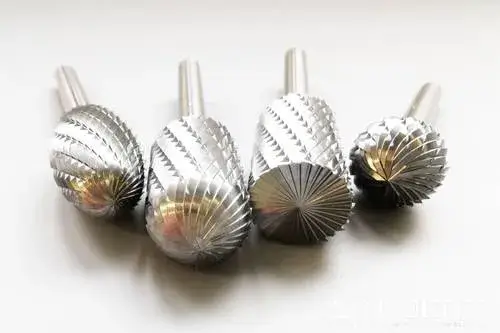
Various rotary carbide burrs
Which Machines are Compatible with Carbide Burrs?
To achieve optimal performance with a carbide burr, it is crucial to pair it with a compatible drill machine. The most effective pairing is with die grinder machines, earning them the colloquial term "die grinder bits." However, several other drill machines prove compatible with carbide burrs, particularly air tools such as:- Die grinders.
- High-speed engravers.
- Pneumatic rotary tools.
- Micromotors.
- Flexible shafts.
- Pendant drills.
A valuable consideration when selecting a drill machine for your carbide burr is to ensure it runs true. This means the burr should not exhibit any wobbling while performing its functions on the designated material. A carbide burr that tilts may result in vibrations, leading to uneven grinding when applied to specific materials. Consequently, this could yield inaccurate results.
In essence, choosing a drill machine that maintains stability ensures the carbide burr operates smoothly and delivers precise results across a variety of materials.
Which People Can Use Carbide Burrs?
Carbide burrs find extensive utility across various industries worldwide, serving diverse applications including:- Toolmaking.
- Metalworking.
- Wood carving.
- Toolmaking.
- Jewelry making.
- Welding.
- Deburring.
- Cylinder head porting.
- Sculpting.
- Engineering.
- Model engineering.
- Dental.
- Aerospace.
- Automotive.
- Metal sculpting.
- Agriculture.
- Metalsmith.
- Shipyard.
- Stone.
Which Types of Cuts do Carbide Burrs Provide?
Carbide burrs come in two common cuts: single cut and double (diamond) cut. Each cut features a unique teeth or flute structure, influencing their applications.
Single Cut:
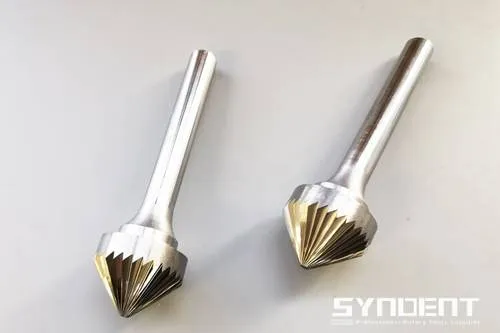
Single-cut tungsten carbide burrs
Single cut carbide burrs possess single right-handed spiral flutes with an up-cut design. This design allows them to efficiently process various materials, including:
- Hardened steel.
- Stainless steel.
- Cast iron.
- Carbon steel.
- Iron steel.
- Ferrous metals.
Double Cut (Diamond Cut):
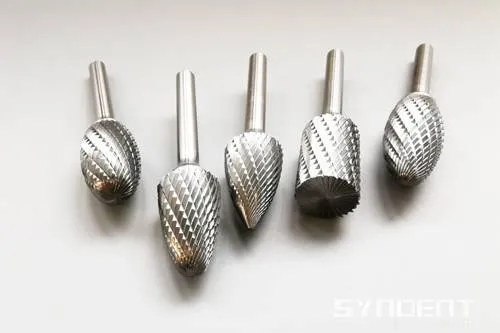
Double-cut rotary carbide burrs
Double-cut carbide burrs have intersecting double flutes, resulting in sharp fine cuts. This design provides a smoother finish compared to a single cut. They are versatile and widely used across industries due to their ability to remove material faster, sometimes referred to as cross-cut or diamond cut.
Double-cut carbide burrs are suitable for various applications, including:
- Creating smaller chips.
- Removing medium to light stock.
- Deburring different materials.
- Fine finishing.
- Smooth finishing.
- Cleaning various materials.
- Aluminum.
- Mild steel.
- Magnesium.
- Copper.
- Zinc alloys.
- Brass.
- Hard rubber.
- Different plastics.
- Non-ferrous materialss.
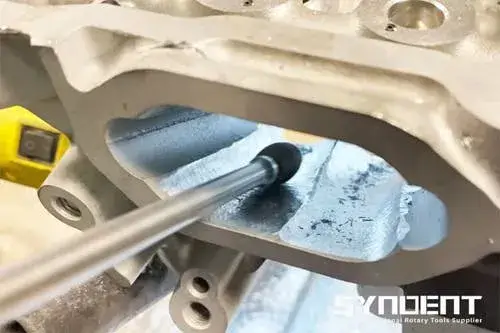
Aluminum carbide burrs
How Many Shank Sizes of Carbide Burrs Can You Find?
The shank size of a carbide burr refers to the portion that fits into a compatible handpiece, essentially the opposite end from the working end of the carbide burr. Typically, carbide burrs are available in various shank sizes, including:| No | Burr Shank Size |
|---|---|
| 1 | 2.35 mm |
| 2 | 3.0 mm |
| 3 | 1/8” |
| 4 | 6.0 mm |
| 5 | 1/4” |
| 6 | 10.0mm |
| 7 | 3/8” |
The diversity in shank sizes offers a range of options for use in different machines. Users can also apply these bits across various applications when working with different materials.
The choice of shank size is often influenced by the nature of the workpiece, determining the required size for a specific task. Categorizing applications based on shank sizes reveals that smaller-sized carbide burrs are ideal for lighter tasks.
Smaller carbide burrs excel when operated at high speeds, providing a fine, smooth finish. Conversely, larger-sized carbide burrs are essential for efficiently removing bulk materials and managing larger tasks, yielding better results compared to their miniature counterparts.
When using large-sized carbide burrs, it is advisable to operate them at the lowest RPM available. This approach ensures optimal outcomes and aligns with achieving the intended superior results. In essence, understanding the implications of different shank sizes allows users to make informed choices based on the specific requirements of their tasks.
What Are the Different Shapes of Carbide Burrs and Their Applications?
In addition to various sizes, carbide burrs come in a multitude of shapes, each tailored for specific applications within the industry. Before choosing a carbide burr shape, understanding its intended cut is crucial, as different profiles can adeptly fit into nooks and crannies, ensuring quality results on various materials.Carbide Ball Burrs
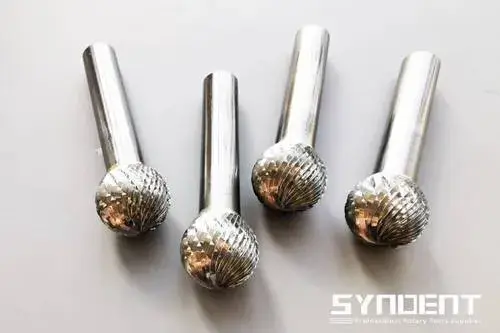
Carbide ball burrs
Carbide ball burrs feature a grinding head resembling a ball or sphere, creating a concave cut in the material. They come in small and large sizes, ranging from 0.5 mm to 25 mm in diameter. Small carbide ball burrs are ideal for intricate carving projects, while large ones handle heavy tasks. Widely used in hobby drills, high-speed, and micro motor handpieces, these burrs find applications in stone carving, woodcarving, and stone engraving.
Carbide Tree Burrs
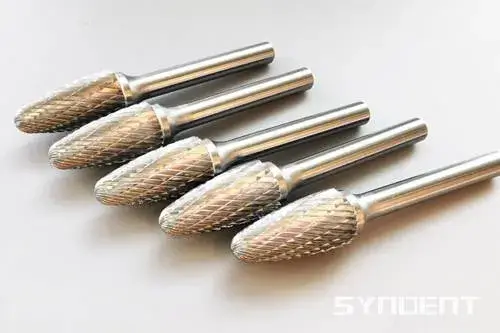
Tree carbide burr
Carbide tree burrs, shaped like a tree with a pointed or ball nose, are designed to round off edges and make precise concave cuts. Pointed end tree burrs are useful for reaching hard-to-cut areas or contours with acute angles.
Carbide Inverted Cone Burrs
Inverted cone burrs have a cone shape with a sliced upper part, enabling V cuts on materials. They are also effective for chamfering the rear side of a workpiece.
Carbide Pointed Cone / Carbide Round Nose or Ball Nose Burrs
Pointed cone burrs have a sharp tip for cutting in hard-to-reach positions, while round or ball nose cone burrs offer precise grinding in rounded edges, providing an excellent surface finish.
Carbide Cylinder Burrs; Round Nose / Ball Nose / End Cut
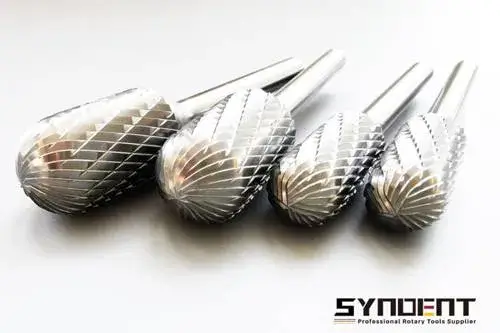
Round nose carbide burr
Cylinder burrs can have a round/ball nose or a flat end with or without an end cut. End cut burrs are suitable for contour finishing, while those without an end cut assist in processing right-angled corners. They can also be found in ball nose or round nose forms for grinding contours and arc-surfacing materials.
Carbide Oval Burrs
Oval burrs, shaped like an oval, efficiently remove round edges from workpieces.
Carbide Flame Burrs
Flame-shaped carbide burrs are effective in machining round edges on specific materials.
Oblate Spheroid Carbide Burr
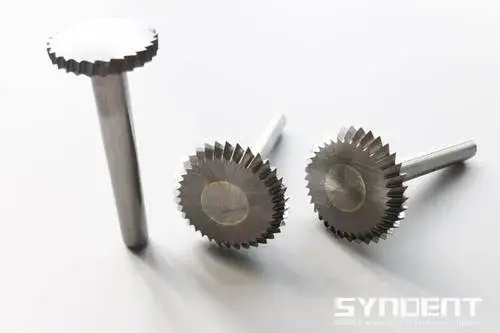
Oblate spheroid carbide burr
Oblate spheroid burrs resemble a wheel with a flat end and rounded edges, excelling in cutting, carving, stock removal, and defining workpieces, particularly in processing complex substances.
Carbide Countersink Burrs
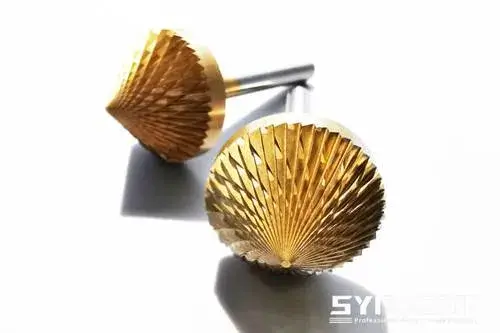
Carbide countersink burr
Countersink burrs, available in 60 and 90-degree shapes, are effective in chamfering, bevelling, and counter-boring, especially in workpieces with acute angles.
Understanding the diverse shapes of carbide burrs allows users to choose the most suitable profile for their specific applications, ensuring precision and efficiency in material processing.
Do Carbide Burrs come in Various Sets, and Can You Have Custom Designs?
Absolutely. When tackling minor carving projects demanding intricate detailing, having an array of carbide burrs becomes essential. Not only should these carbide burrs come in various shapes, but having a set of them proves invaluable.
The right carbide burr set provides numerous options, catering to the diverse requirements of your project. These sets typically encompass different sizes of carbide burrs, allowing users to select a set with specific shank and head diameters tailored to their needs.
For smaller carving projects, a compact set of carbide burrs can deliver exceptional performance, offering versatility in tool selection. Clients also have the option to request custom-designed carbide burr sets. Personalized sets can include tools with specific shapes and sizes, allowing users to meet the unique demands of their projects.
In summary, whether opting for a pre-packaged set or a customized collection, having a variety of carbide burrs ensures you have the right tools at your disposal, enhancing precision and efficiency in your carving endeavors.
How Can You Find a suitable Cut for Carbide Burrs?
As highlighted, carbide burrs come in two prevalent cuts - single-cut, double-cut, and occasionally aluminum cut. Each cut is tailored to process materials differently, making it crucial to select the appropriate cut based on the nature of your workpiece and desired outcomes.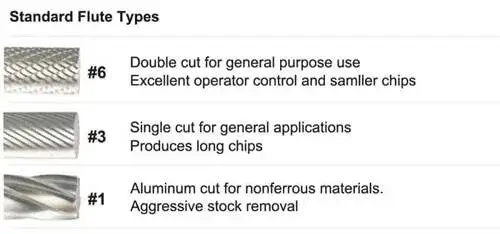
Standard burrs flute type
Manufacturers produce carbide burrs in distinct cuts, each offering additional functions and performing optimally on specific materials. Here's a breakdown of the primary cuts and their applications:
- Single Cut:
- Ideal for heavy material removal, deburring, cleaning, creating long chips, or milling.
- Well-suited for processing hardened steel, stainless steel, copper, and various ferrous metals.
- Double Cut:
- Effective on ferrous and stainless steel, providing excellent performance on mild steel, aluminum, and other non-metallic materials.
- Removes medium to light fabrics and excels in polishing and finishing applications.
- Aluminum Cut:
- Specifically designed for non-ferrous materials such as aluminum, magnesium, copper, and more.
| Material | Single Cut | Double Cut | Aluminum Cut |
|---|---|---|---|
| Hardened Steel | ✓ | ✓ | |
| Stainless Steel | ✓ | ✓ | |
| Copper | ✓ | ✓ | |
| Ferrous Metals | ✓ | ✓ | |
| Mild Steel | ✓ | ✓ | ✓ |
| Aluminum | ✓ | ✓ | |
| Non-Metallic Materials | ✓ | ✓ |
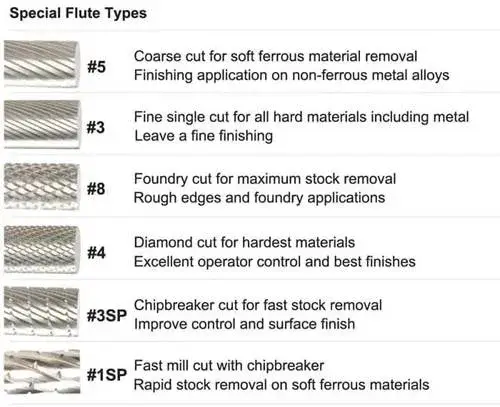
Special flute types of burrs
In order to have a quick reading, you can check the below chart. What the different materials are suitable worked by right flutes. You can understand them within one second.
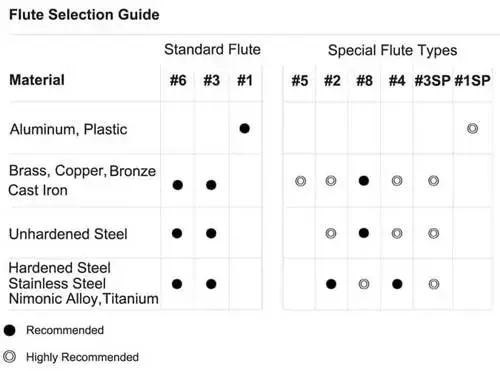
Materials worked by different flutes
Which Speed/RPM Should One Choose for Carbide Burrs?
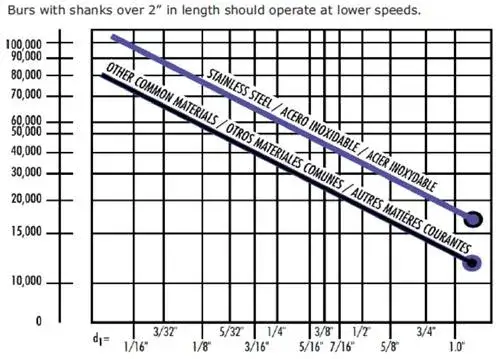
Burr speed recommendations
Choosing the right speed or RPM for carbide burrs in your handpiece depends on several factors. The material being worked on plays a crucial role in determining the optimal speed, as different materials have varying qualities.
When grinding hard materials like hardened steel, a higher speed is recommended. Conversely, for softer materials like aluminum, a lower speed is preferable to avoid damaging the material.
Carbide burrs come in diverse shapes and sizes, each operating optimally within specific speed ranges. Larger head diameters require lower speeds for better control during use. On the other hand, smaller head diameters can handle higher speeds without sacrificing control.
Manufacturers specify speed ranges suitable for different carbide burr sizes and shapes. An approximate range might be presented in the table below:
| No | Burr Size | RPM |
|---|---|---|
| 1 | 2.0 mm | 17 000 – 26 000 |
| 2 | 3.0 mm | 17 000 – 26 000 |
| 3 | 6.0 mm | 11 000 – 16 500 |
| 4 | 13.0 mm | 8 000 – 12 000 |
| 5 | 16.0 mm | 7 650 – 11 500 |
However, it's generally advised not to exceed an overall speed of 35,000 RPM.
Important Note: Chipping may occur during use, indicating a need for a lighter speed. Starting with a slow cutting speed and gradually increasing it is recommended. Following recommended high-speed ranges helps prevent clogging in the flutes of carbide burrs.
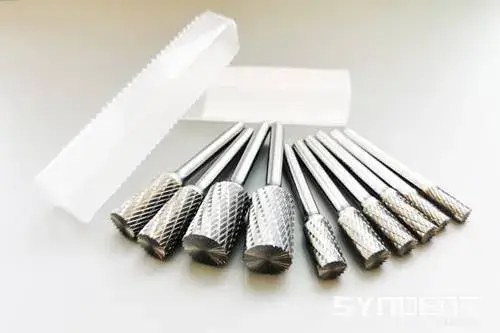
Different diameter carbide burrs
What Amount of Pressure Should You Apply with Carbide Burrs?
When using carbide burrs, employ minimal pressure during cutting operations and allow the burr to execute its function effectively.Carbide, being a rigid and exceptionally sharp material, imparts these qualities to cutting tools like burrs. The sharp flutes of carbide burrs are designed to swiftly cut through various materials without necessitating excessive pressure on the workpiece.
Applying more pressure than necessary can result in detrimental effects such as chipping or rapid dulling of the burr's cutting edges. Additionally, excessive pressure may lead to uneven cuts on the material. Therefore, it is advisable to work with carbide burrs using a gentle touch to ensure optimal performance and prolong the life of the cutting tool.
Are Carbide Burrs Harder Than High-Speed Steel (HSS)?
Certainly.Manufacturers typically produce high-quality carbide burrs through precision machining of specially selected carbide grades.
Carbide, in reality, exhibits an exceptional hardness, being twenty times more rigid than High-Speed Steel (HSS). Notably, it stands as the second-hardest material globally, trailing only behind diamond.
The remarkable rigidity of tungsten carbide compounds makes these tools highly suitable for more challenging tasks. Tungsten carbide burrs outperform HSS in various aspects, enduring higher temperatures and excelling in prolonged applications.
In contrast, HSS burrs tend to soften quickly at elevated temperatures. Therefore, carbide burrs, with their superior hardness, offer a distinct advantage in durability and performance, especially in applications involving higher temperatures.
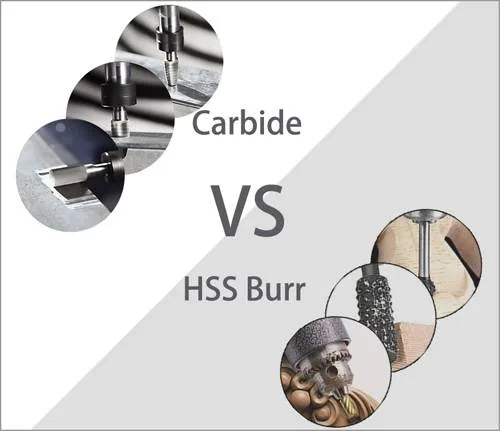
Carbide burrs VS HSS burrs
What Are the Benefits of Using Carbide Burrs?
Investing in carbide burrs comes with various advantages. These burrs are composed of tungsten carbide, known for its exceptional hardness, surpassing most metals except for diamond.The inherent sharpness of carbide makes burrs highly effective for cutting various materials quickly and precisely. The remarkable rigidity of carbide contributes to the durability of the burrs, allowing for prolonged use when applied with care.
To maximize durability, it's recommended not to force the burr but rather let it grind smoothly without excessive pressure. This approach enhances flute longevity while ensuring accurate results.
Carbide burrs are available in a variety of shapes and sizes, offering versatility for different applications. Larger burrs are ideal for bulk material removal, while smaller ones are effective for grinding tight angles and hard-to-reach areas.
The use of hard-wearing carbide steel as raw material further enhances the strength of carbide burrs. This allows for cutting through rigid materials such as hardened steel, carbon steel, and alloy steel with ease.
Carbide burrs enable faster cutting rates compared to other tools, increasing work efficiency while reducing energy consumption. Their diverse shapes and sizes make them adaptable to a wide range of projects, providing benefits such as:
- Extended longevity
- Increased production efficiency
- Bulk material removal
- Processing various rigid materials
- Deburring, engraving, carving, shaping, and cutting
- Smoothing welds, molds, forging, and dies.
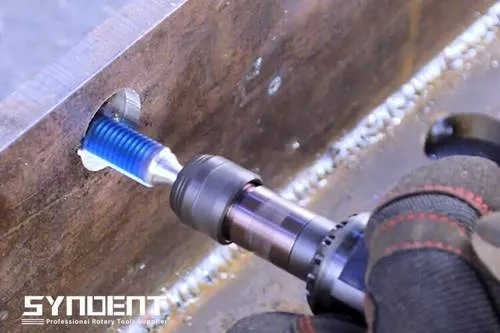
Smooth cutting by the carbide burrs
Why Should the Carbide Burr Grind in A Continuous Motion?
When utilizing a carbide burr in a die grinder for material grinding, maintaining a continuous motion is essential for several reasons. Continuous motion ensures a progressive cut without breaks or prolonged stillness.Extended stillness or interruptions in motion can adversely impact the burr's cutting efficiency, resulting in uneven surfaces and unsightly marks on the material being worked on.
By keeping the carbide burr in continuous motion, users can achieve more consistent and better results. Carbide burrs are precision-engineered tools with sharp blade-like flutes, allowing for precise and accurate outcomes in various projects.
Utilizing an "upstroke" at the end of the grinding process can contribute to a smoother finish on the workpiece. Additionally, maintaining continuous motion is beneficial for declogging carbide burrs, especially when working on softer materials like cast iron.
In summary, grinding with a carbide burr in continuous motion ensures a smoother and more efficient cutting process, leading to improved outcomes in various applications.
What are the Differences Between Carbide Burrs and Countersink?
A countersink embodies a cutting instrument crafted from materials such as carbide, high-speed steel, diamond, and cobalt steel.Additionally, it adopts a conical configuration, facilitating the utilization of a countersink cutter for the creation of conical holes or chamfering inner orifices. Furthermore, it serves the purpose of expanding the periphery of a designated aperture.
Versatile in its capabilities, a countersink adeptly processes materials ranging from wood to metal and plastics. Its fluted design ensures precise and clean incisions across diverse workpieces.
Beyond its cutting prowess, a countersink plays a role in refining the finishing touches of a product by eliminating burrs that may persist after tapping or drilling operations, consequently enhancing the smoothness and safety of the final product.
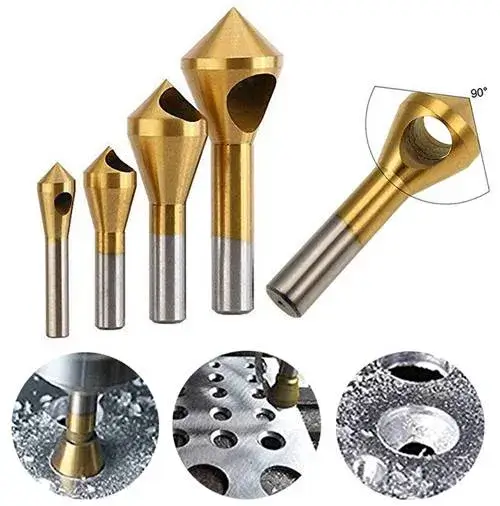
Applications of countersink
The primary geometry of a countersink seamlessly accommodates both plunging and milling applications, showcasing its versatility with overlapping configurations tailored for various functions. It can even be colloquially referred to as a chamfering endmill featuring an angled tip.
Irrespective of nomenclature, a countersink serves the dual roles of facilitating plunging and traversing operations. The former involves conical chamfering, while the latter entails the intersection of two planes.
Much like their counterparts, carbide burrs, countersinks find compatibility with various handpieces, including milling machines, drill presses, lathes, and drills.
An intriguing variant is the fluted countersink, specifically engineered to execute robust chamfering at the inception of a drilled aperture.
Manufacturers exercise the liberty to fashion countersinks in an array of engagement angles, ranging from 60° to 140°, adhering to either English or metric standards.
In contrast to carbide burrs, the countersink cutter boasts large flutes designed for efficient bulk chip removal while maintaining a cutting discharge prowess akin to carbide burrs.
While carbide burrs deliver a powerful cutting discharge, their cutting performance is notably smoother compared to countersinks.
Nevertheless, both countersinks and carbide burrs find utility in materials such as aluminum alloy, stainless steel, copper, and more.
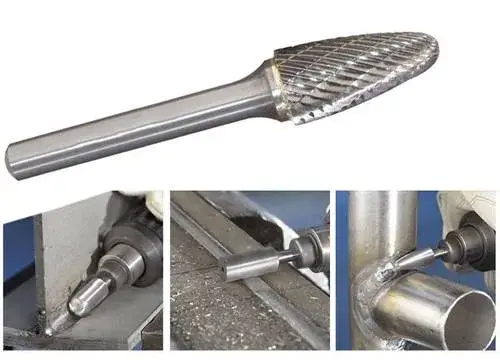
Applications of carbide burrs
Can Carbide Burrs Undergo Sharpening?
Negative.The necessity to sharpen carbide burrs is nonexistent. Furthermore, tools tailored for honing the flutes of these burrs are notably absent. Consequently, the architects of carbide burrs engineer them with an exceptionally protracted lifespan in mind.
A pivotal attribute of this tool lies in its distinctive construction material—tungsten carbide, a substance renowned for its superior durability compared to high-speed steel.
Hence, it boasts unparalleled longevity, delivering peak performance over numerous months or even years before contemplating replacements.
However, the manner in which you wield these burrs and the rigors of their applications do impact their longevity. Periodic use may defer blunting for a year or more, while daily usage might necessitate replacement every four months or sooner.
Moreover, adhering to recommended applications and materials preserves the robust cutting prowess of carbide burrs. Employing them judiciously ensures the retention of their keen edges.
Additionally, employing the right grinding technique augments the overall performance of carbide burrs, enhancing their longevity and sharpness.
During the machining process with a carbide burr, exerting excessive pressure on the material is ill-advised. Optimal results are achieved by applying a measured force, allowing precise cutting without compromising the integrity of the burr's flutes.
In practical terms, employing modest pressure proves effective in material removal, yielding high-quality results without hastening the wear and tear of the carbide burr's flutes.
Can You Use Carbide Burrs for Aluminum and How Do You Use Them?
Yes.Carbide burrs, precision-engineered cutting instruments with sharp blade-like flutes, demonstrate remarkable versatility in material processing. Crafted from a raw material of optimal strength—tungsten carbide—the flutes allow for the efficient cutting of various materials, including aluminum and other metals.
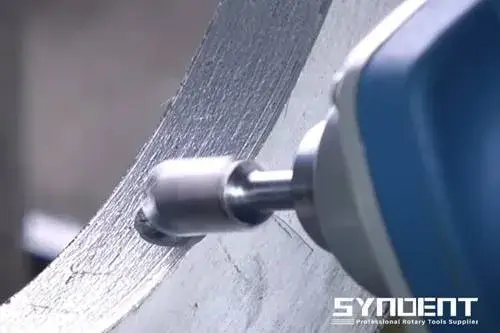
Carbide Burr For Aluminum
Aluminum, being one of the softer non-ferrous metals, finds extensive use in diverse industries such as construction, aviation, and electronics. Carbide burrs prove to be exceptional tools for processing aluminum, delivering precision and efficiency.
To optimize aluminum cutting, the use of dedicated carbide burrs tailored for aluminum applications is recommended. These specialized burrs ensure superior results when working with non-ferrous metals like aluminum.
The distinctive design of carbide burrs for aluminum includes broad and deep flutes, surpassing the standard burrs. This unique feature facilitates convenient and rapid stock removal without debris accumulation between the flutes.
This tailored design not only aids in heavy stock removal but also minimizes chip loading. The prevention of iron-chip accumulation and over-heating safeguards the cutter head from potential damage.
Whether you're a novice, hobbyist, or professional in metal craftsmanship, aluminum carbide burrs prove to be indispensable tools. Their ease of use ensures that users of all skill levels can master their application, providing exceptional performance on non-ferrous metals, wood, plastics, and more.
The diverse shapes and sizes of aluminum carbide burrs make them compatible with standard handpieces available in the market. This adaptability extends to various applications on soft materials, including cutting, grinding, drilling, shaping, carving, engraving, polishing, chamfering, and more.
Professionals and beginners alike benefit from the efficiency of aluminum carbide burrs in material removal with minimal effort. The pointed tips of certain burrs enable access to challenging areas on a workpiece, while others with larger head diameters excel at bulk material removal.
In practice, the versatility of these burrs allows for grinding in any position on the workpiece. Whether it's intricate detailing with pointed tips or efficient bulk material removal with larger heads, aluminum carbide burrs offer convenience and precision, ensuring successful completion of various projects.
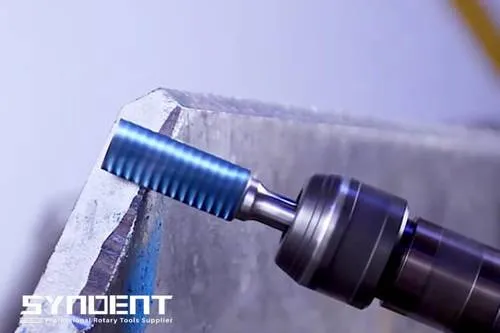
Carbide burrs for other non-ferrous metals
Can You Use Carbide Burrs for Carving Wood and How Do You Use Them?
Carbide burrs stand out as precision-engineered tools, offering exceptional versatility in material processing. Manufacturers employ high-strength tungsten carbide steel to create robust, sharp, and enduring grinding tools, allowing these devices to adeptly handle various materials, including wood.Specifically tailored carbide rotary files cater to wood cutting needs, providing an excellent solution for tasks on hard wood.
Wood carving carbide burrs, crafted from carbide steel, boast superior cutting edges, optimal strength, and durable capabilities. These cutting edges ensure precise and effortless operation, while the overall robustness of the burrs contributes to an extended tool life.
The impressive heat dissipation abilities of carbide burrs for wood carving enable them to perform consistently under challenging conditions. Unlike diamond, which may scratch the workpiece, the burr's flutes cut through the wood with minimal friction, generating little heat.
The optimum design of carbide burrs for wood carving results in hybrid performance, offering rapid material removal alongside excellent surface quality. This combination provides a comfortable and efficient experience when utilizing carbide burrs for wood carving.
Wood carving carbide burrs excel in various tasks, including shaping, contouring, notching, trimming, and making precise adjustments. The exceptional performance and quality design of these burrs extend their applicability to processing other materials such as glass, plastic, rubber, drywall, nail gel, fiberglass, soft stone, and even bones, making them a versatile tool for diverse tasks.
Equipped with multiple shapes, carbide burrs for wood carving can cater to various requirements for your workpiece. For instance, a ball nose design offers versatility, allowing you to use its flat side for rapid rounding over edges or the rounded nose for creating fillets in corners. The round nose proves effective in hollowing out recessed areas or crafting radius-bottom grooves.
In practice, the comprehensive capabilities of carbide burrs make them indispensable for professionals and enthusiasts alike, serving as a go-to cutting tool for a wide array of applications.
Can You Use Carbide Burrs for Die Grinders?
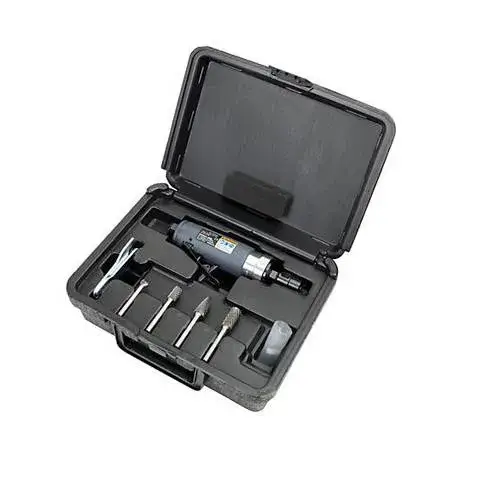
Wood carving carbide burrs
Yes.
Carbide burrs demonstrate exceptional utility when employed in die grinders, making them versatile tools for a range of applications.
These rotary files or die grinder bits can be effectively attached to compatible drill machines, allowing carbide burrs to deliver outstanding performance. The die grinder's spinning motion, facilitated by the drill machine, enables the carbide burr to cut through various materials with precision.
Carbide burrs are well-suited for processing ceramics, stainless steel, titanium, wood, hardened steel, carbon steel, aluminum, and more when integrated into a die grinder.
It's crucial for the carbide burr to fit securely and without wobbling in its position within the die grinder. The collet of the die grinder holds the burr in place, and using a wrench can help achieve a tighter fit. This not only enhances performance but also reduces wobbling and vibrations during material cutting.
Die grinders, functioning as drill machines, are widely used across diverse industries in conjunction with carbide burrs due to their effectiveness.
While die grinders are the primary choice for utilizing carbide burrs, other air tools such as pneumatic rotary tools, high-speed engravers, micro motors, flexible shafts, pendant drills, and hobby rotary tools can also serve the same purpose. When selecting a handpiece for carbide burrs, it is essential to choose one that runs true without any wobbling.
In essence, the compatibility of carbide burrs with die grinders and other related tools underscores their versatility and makes them invaluable for various material processing tasks.
How Do You Recognize The Best Carbide Burrs?
ChoosingChoosing the right tool for your work can significantly impact efficiency and results, and finding the best carbide burrs is a crucial step that can prove challenging. Here's a comprehensive guide on how to recognize the best carbide burrs:
-
Raw Material Quality:
Carbide burrs come in various qualities due to differences in the grades of raw materials. Syndent, a Chinese company, stands out for using top-grade raw materials, specifically Carbide K20 and K25. These materials ensure better rigidity and enhanced longevity, contributing to prolonged tool lifespan and outstanding performance. -
Brazing Strength:
The best carbide burrs should feature strong brazing when joining the grinding head to the shaft. Syndent employs diversified options of brazing, including silver brazing, ensuring optimum strength. This guarantees that the brazing position won’t break or bend, regardless of the task the carbide burr is subjected to. -
Shank Quality:
Consider the quality of the shank, as it is crucial for overall durability. Syndent utilizes a Japanese steel shank known for maximum strength, preventing bending or breaking when exposed to different tasks. -
Manufacturing Process:
The manufacturing process plays a pivotal role. Syndent uses five-axis CNC machines to process carbide burrs, ensuring sharp and durable teeth, deep flute grooves for accurate cuts, and a helicity (spiral) flutes option for excellent performance. -
Polishing Technology:
Recognize the best carbide burrs based on the polishing technology used. Syndent employs unique polishing technology, resulting in a surface that shines like stainless steel. -
Packaging Quality:
Quality and attractive packaging are indicators of the best carbide burrs. Syndent utilizes high-grade PP material boxes for packaging, ensuring safe storage and protection when the burrs are not in use.

Advanced CNC for your carbide burrs
Considering these factors when selecting carbide burrs ensures that you invest in high-quality tools that deliver longevity, optimal performance, and safety in storage. Syndent's commitment to excellence in materials, manufacturing processes, and packaging positions their carbide burrs as a reliable choice for professionals seeking top-tier performance.
How Do You Define the Best Carbide Burrs Supplier?
In a growing industry with a rising demand for carbide burrs, identifying the best supplier becomes crucial. Here's a comprehensive guide to defining the best carbide burrs supplier:-
Quick and Effective Communication:
A top-notch carbide burrs supplier should have a responsive communication platform, addressing clients' inquiries promptly and efficiently around the clock. -
Emphasis on Local Sales Support:
Instead of solely selling carbide burrs, the best supplier should focus on assisting customers in selling the burrs locally. This approach enhances accessibility for potential buyers. -
Use of Quality Raw Materials:
Quality materials are a key factor in defining the best carbide burrs supplier. Syndent stands out by using top-grade raw materials, specifically Carbide K25 and K20, ensuring enhanced rigidity for long-lasting industrial carbide burrs. -
Automatic Brazing Equipment:
The best supplier employs the latest automated brazing equipment, ensuring a firm bond in the carbide burrs and instilling confidence in users. -
Production on 5 Axis CNC Machines:
The choice of production equipment is critical in determining the quality of carbide burrs. Syndent manufactures their burrs using five-axis CNC machines, promising high-quality products and establishing themselves as a top carbide burrs supplier globally. -
Qualified Quality Control Personnel:
The number and qualification of quality control personnel play a significant role. A supplier with an adequate number of qualified staff can ensure prompt oversight of the quality control process, producing the best carbide burrs for various industrial applications. -
Detailed Process Monitoring:
The best supplier implements a unique quality control system, meticulously monitoring every production process to ensure that carbide burrs meet all industrial standards. -
Trusted Payment Methods:
Consider the payment methods offered by a supplier. The best carbide burrs supplier provides reliable and trusted payment options, offering flexibility and security to clients. -
Fast and Reliable Delivery:
The delivery speed is a crucial factor in defining the best carbide burrs supplier. Opt for a supplier with a reputation for fast and reliable deliveries, meeting clients' expectations. -
Guaranteed After-Sales Service:
A reputable supplier should provide a straightforward warranty on their products and have an effective communication platform to address customer requests, ensuring excellent after-sales service.
Considering these factors when selecting a carbide burrs supplier ensures that you partner with a reliable and customer-focused source, ultimately contributing to a positive experience and successful outcomes in your industrial applications.
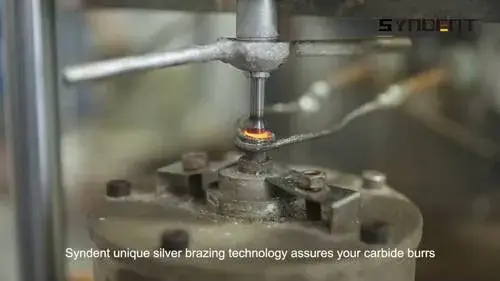
Automatic brazing tech for the carbide burrs
Can You Find the Same Quality As Carbide Burrs Made In USA, UK, And Australia From Syndent Tools?
Yes.Certainly.
Syndent Tools ensures the same high quality as carbide burrs made in the USA, UK, and Australia. Here's how Syndent Tools matches the quality of carbide burrs from these renowned regions:
-
Premium Carbide Quality:
Carbide burrs made in the USA are known for their high quality, utilizing premium carbide. Similarly, Syndent Tools employs top-grade carbide raw materials to manufacture burrs, ensuring the same level of quality and performance. -
Advanced Welding Equipment:
The USA and UK utilize the latest welding equipment and technology for processing premium-quality carbide burrs. Syndent Tools is no exception, utilizing advanced CNC equipment and ultra-modern welding technology from the USA, guaranteeing the highest quality in their carbide burrs. -
Optimum Strength and Durability:
Carbide burrs from the UK and Australia are recognized for their superb quality, featuring optimum strength and durability. Syndent's commitment to using quality carbide steel ensures that their burrs, like those from the UK and Australia, offer outstanding performance, especially in slicing hard and soft metals, as well as non-metallic materials. -
Versatile Applications:
Just like carbide burrs in Australia that can be used on various materials such as acrylics, plastics, wood, and fiberglass, Syndent's carbide burrs are versatile and suitable for a wide range of applications. -
11 Years of Manufacturing Expertise:
Syndent has been dedicated to manufacturing quality tools for the past 11 years. This extensive experience reflects the company's commitment to producing carbide burrs of the highest standard.
What Could Cause My Carbide Burrs Not To Work Well On Steel and Stainless Steel?
Several factors could contribute to carbide burrs not working effectively on steel and stainless steel. Here are some possible reasons:-
Incorrect Type of Burrs:
It's essential to use the correct type of burrs for specific materials. Using a steel-cut carbide burr for steel and a stainless steel-cut burr for stainless steel is crucial. Using the wrong type may result in inefficient cutting and reduced tool life. -
Worn or Dull Burrs:
Carbide burrs wear down over time due to regular use. If your burrs are worn or dull, they won't cut effectively. Regularly inspect and replace burrs that show signs of wear to maintain optimal performance. -
Inadequate Speed or RPM:
The speed at which the burrs rotate, measured in RPM (Revolutions Per Minute), is critical. Using an incorrect speed for the specific type of burr and material can result in poor performance. Consult the manufacturer's recommendations for the appropriate speed. -
Insufficient Lubrication or Cooling:
Inadequate lubrication or cooling during the cutting process can cause the burrs to overheat. This can lead to reduced cutting efficiency and damage to the burrs. Ensure proper lubrication or cooling, especially when working with tough materials like steel and stainless steel. -
Incorrect Technique:
Using the wrong technique, such as applying too much or too little pressure, can impact the performance of carbide burrs. Follow recommended guidelines for the correct cutting technique to achieve optimal results. -
Material Hardness:
Carbide burrs are designed for specific hardness levels of materials. If you're working with exceptionally hard steel or stainless steel, you may need specialized carbide burrs with enhanced hardness for effective cutting. -
Poor Quality Burrs:
Using low-quality or improperly manufactured carbide burrs can result in subpar performance. Ensure that you are using high-quality burrs from a reputable supplier to guarantee effectiveness on steel and stainless steel. -
Improper Size or Shape:
Using burrs with inappropriate sizes or shapes for the intended application can lead to ineffective cutting. Select the right size and shape of the burr based on the specific task and material.














